Berlin is truly a remarkable city with an astounding amount of fascinating history and plenty of information at your fingertips. Our itinerary covers 3 days in Berlin, however there are more things to do in the city than you could possibly have time for, from museums and castles to cathedrals and memorials. Much of Berlin’s history is far from pleasant, and there are many reminders of its disturbing past, but these reminders serve to enlighten people and further encourage continuing unity and peace in the future. Today Berlin is a happening city full of life and color, and one we know you’ll enjoy visiting.
Berlin is an easily navigable city with an extensive public transportation system that takes you from the airport to the city center and beyond. 3 Days in Berlin is a great amount of time to visit the city’s most impressive highlights. Our Berlin itinerary will send you hopping on and off the metro to experience prominent historical sites as well as its fantastic arts scene and museums. Your experiences at these sites will likely leave you hungry for more and eager to return to experience the rest of the city. 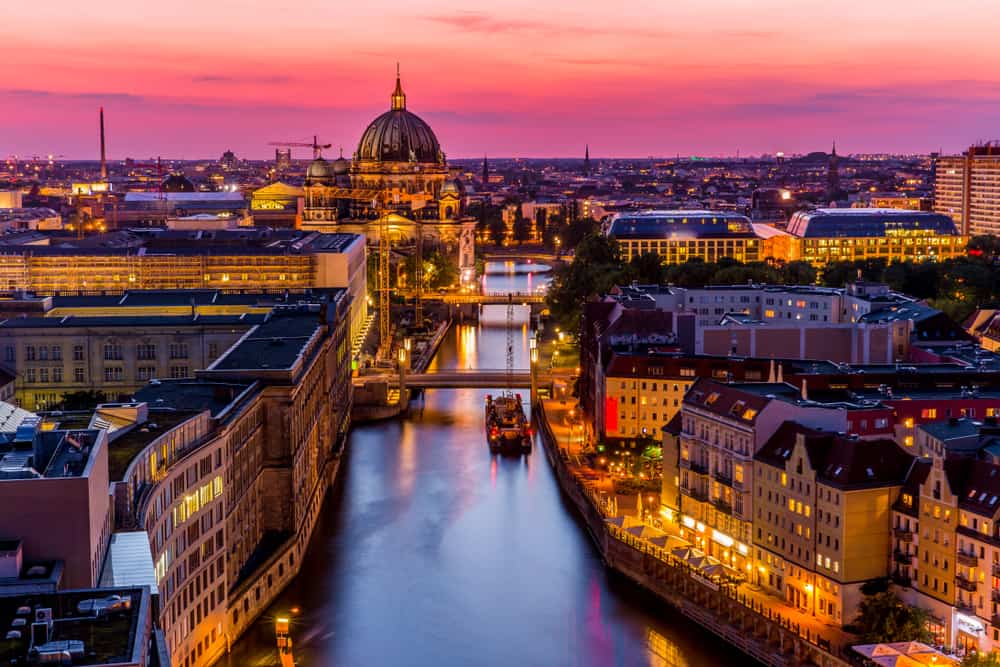
The Ultimate 3 Days In Berlin Itinerary
How To Get To Berlin To Start Your Berlin Itinerary
You have two international airport options when flying into Berlin, Berlin-Tegel or Berlin-Schönefeld. Tegel however has been expected to close for a while now and Schönefeld continues to be expanded in anticipation of it merging with the Brandenburg airport set to open next year. So while both are an option for now, Schönefeld, or its future equivalent, will likely be the safer and perhaps only option down the road.
There are a couple of convenient ways to get from the airports to the city center, assuming you are not renting a car. The first is the airport express train, which is the quickest mode of transportation. However, if you plan to take the metro around Berlin and have bought a Berlin WelcomeCard you might want to consider taking the metro from the airport. A combination of the S-Bahn and the U-Bahn will get you all the way to the city center from Schönefeld.
We highly suggest purchasing a Berlin WelcomeCard for your 3 Days in Berlin. You can purchase a 72-hour card that will allow you unlimited transport on Berlin’s public transportation systems during your stay. There are a couple things to note when choosing a WelcomeCard.
There are Berlin City Center AB cards, which will get you around the city center and from the Berlin-Tegel airport to the city center. This should be enough if you plan to stay within Berlin and fly into Tegel, or take the airport express from Schönefeld. There are also Berlin+Potsdam ABC cards, which include Potsdam and the Berlin Schönefeld airport. This might be the better option if you choose to substitute one of your days in Berlin for a day in Potsdam.
READ NEXT: Exactly Where To Stay In Berlin By Neighborhood
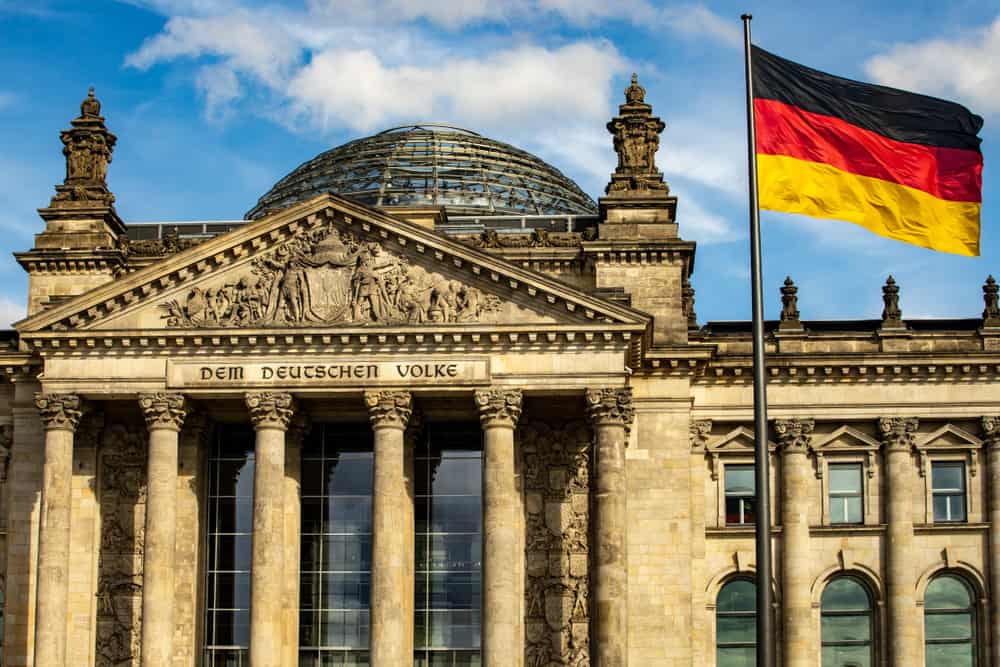
How To Get Around During Your 3 Days In Berlin
Berlin’s public transportation system is fantastic and is the easiest way to get around the city. As we mentioned above, we suggest purchasing a Berlin WelcomeCard to cover your transportation for the duration of your 3 days in Berlin. Choose an AB or ABC card and begin exploring! You should also note that both types of cards offer a 72 hour + Museum Island card. If you plan to follow our Berlin itinerary and spend your second day at Museum Island, this is the best card option for you.
The main public transportation system in Berlin, which includes the U-Bahn, S-Bahn, trams and buses is called the BVG (Berliner Verkehrsbetriebe). The BVG website has important information about ticket options as well as route maps, and allows you to plan out your route and find the best transportation options and connections. There’s also a BVG app that can make tracking the public transit schedules easier while you’re out and about.
If you decide you’d rather rent a car to travel around Berlin, or are perhaps planning an extended Germany road trip, Sixt is a great car rental option. It was founded in Germany and will take care of all your rental car needs. In much of Europe, driving a manual car is more common than driving an automatic. If you’re not familiar with or comfortable with driving a manual car, don’t test your manual skills now. Stick with what you know, particularly when you’re driving in a country with an autobahn that has no speed limit. Sixt however offers an array of automatic cars so you won’t have to worry about struggling with a manual.
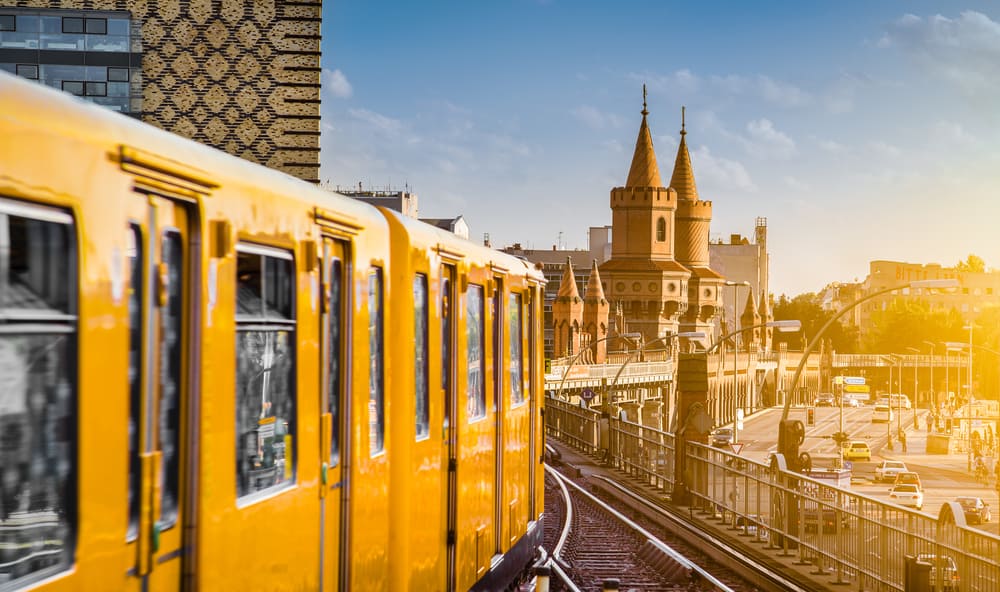
What To Do In Berlin In 3 Days
Day 1: Begin Your 3 Days In Berlin With The History Of The City And A Stroll Through Its Parks and Zoo
You will begin your 3 days in Berlin with a healthy mix of recalling Germany’s dark history, looking forward to its hopeful, united future, and appreciating its natural beauty. It’s impossible to visit Berlin and not delve into the rather heavy history of the capital, but a trip to the zoo and the beautiful, forested Tiergarten should lighten the mood. The first three stops don’t necessarily require a lot of your time, but are definitely worthwhile stops to get a complete picture of Berlin.
Stop 1: Visit The Prominent Brandenburg Gate, A Symbol Of Unity
You can’t go to Berlin and not see the formidable Brandenburg Gate. The gate has stood the test of time (albeit with some renovation after WWII) and has been a staple of Berlin throughout Germany’s history. The gate was constructed from 1788-1791 at the request of Prussian King Frederick William II complete with the impressive Quadriga, a chariot drawn by four horses.
Napoleon marched through the gate and took the Quadriga in triumph in 1806. For many years the gate was only a passageway for royals. And in 1933 as Hitler rose to power, Nazis marched through the gate in celebration. Crowds at the gate heard famous speeches from both Kennedy and Reagan. And when the wall fell between East and West Berlin, the gate became a symbol of unity throughout the country and the spot where spectators watched the spectacularly moving concert lead by the conductor Leonard Bernstein.
Since then, the gate has seen speeches from President Clinton and President Obama and has been lit or unlit in support or protest of events and other countries. It also lights up spectacularly at the annual October Festival of Lights celebration. Today it remains a symbol of peace, freedom and unity and the healing of a country once divided. The gate continues to attract tourists from around the world who long to see the striking piece of architecture, and remember a little slice of Berlin’s history.
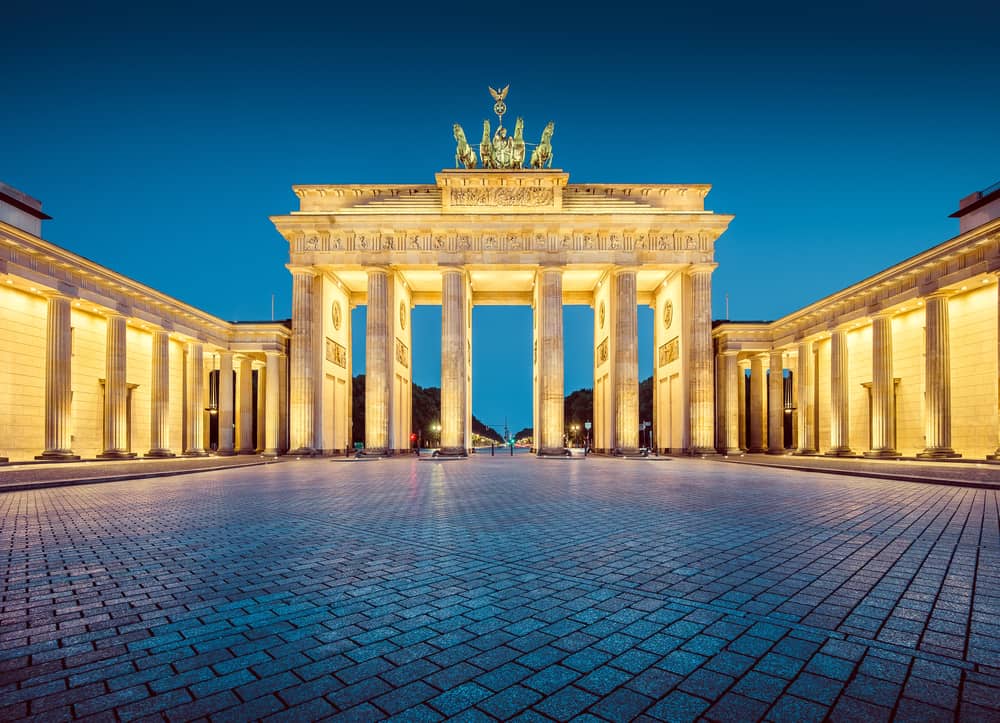
Stop 2: Take A Moment To Reflect On The Past At The Memorial To The Murdered Jews Of Europe
The Memorial to the Murdered Jews of Europe (Holocaust Memorial) is placed prominently and strikingly in the heart of Berlin very near the Brandenburg Gate. Constructed by the architect Peter Eisenman, this memorial differs from most in that there are no names carved into the stone blocks. A total of 2,711 concrete slabs make up the memorial. They are all equal in width, but differ in height, mimicking the slope of the land they’re built on.
The abstract, nameless nature of the memorial is controversial, but there’s no denying the effect the design has on you as you wander through these stelae resembling tombs or coffins, and slowly disappear from view. There’s an information center located underground below the memorial. Here you’ll find the names and stories of victims as well as artifacts.
Stop 3: Take In The Views From The Terrace Of The Reichstag Building
The Reichstag Building, home to Germany’s parliament, is a historical building that with advance registration is open to the public for free. The Reichstag was originally constructed to house the Parliament of the Second Reich. At the end of WWII the building was abandoned, but after the reunification of Germany, the Reichstag Building once more became the meeting place for the Bundestag, Germany’s current Parliament. The roof terrace and glass dome (with a spectacular 360 view of Berlin) are open to the public along with an audio guide. Be sure to book your tickets in advance to ensure being able to see the dome.
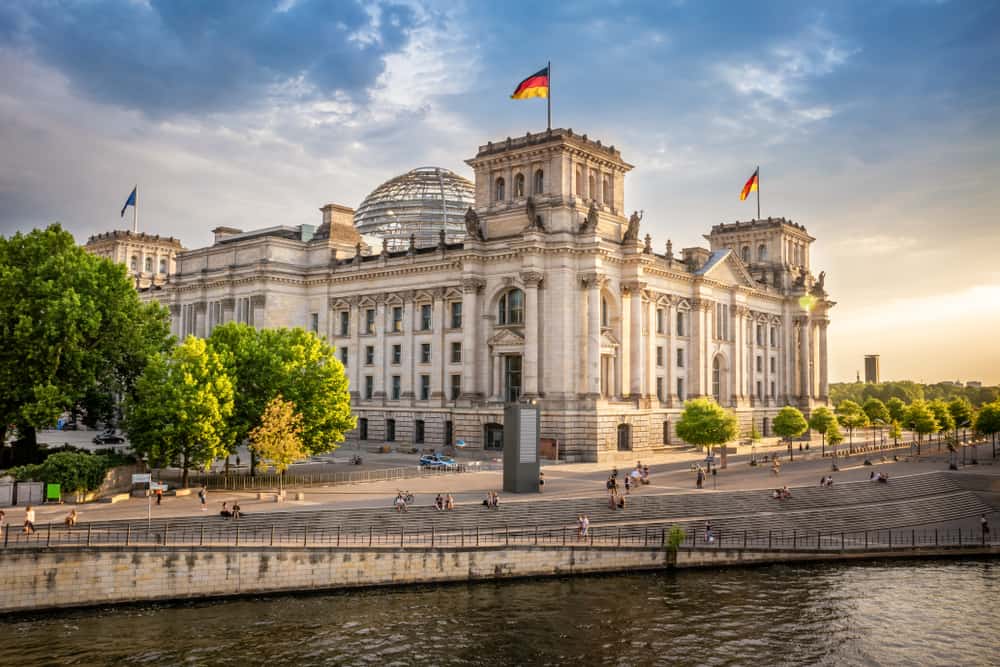
Stop 4: Stroll Through The Tiergarten and Visit The Popular Zoo
The Tiergarten is one of the largest parks in Berlin at 519 acres, and is an integral part of the city, much like New York’s Central Park. Before it was a park, the land was used as the hunting grounds for the Elector of Brandenburg. It later was turned into a park and is enjoyed tremendously by Berlin residents and tourists today. The park has been redesigned and revived over time particularly after the damage it suffered in WWII. Now it is a beautiful, forested park with an abundance of green space for games and relaxation and plenty of paths/trails for walking and running. In the center of the park is the Victory Column commemorating Prussia’s 19th century victory over France. Also located in the Tiergarten is the popular Berlin Zoo. There’s never a shortage of activities to do in the beautiful Tiergarten.
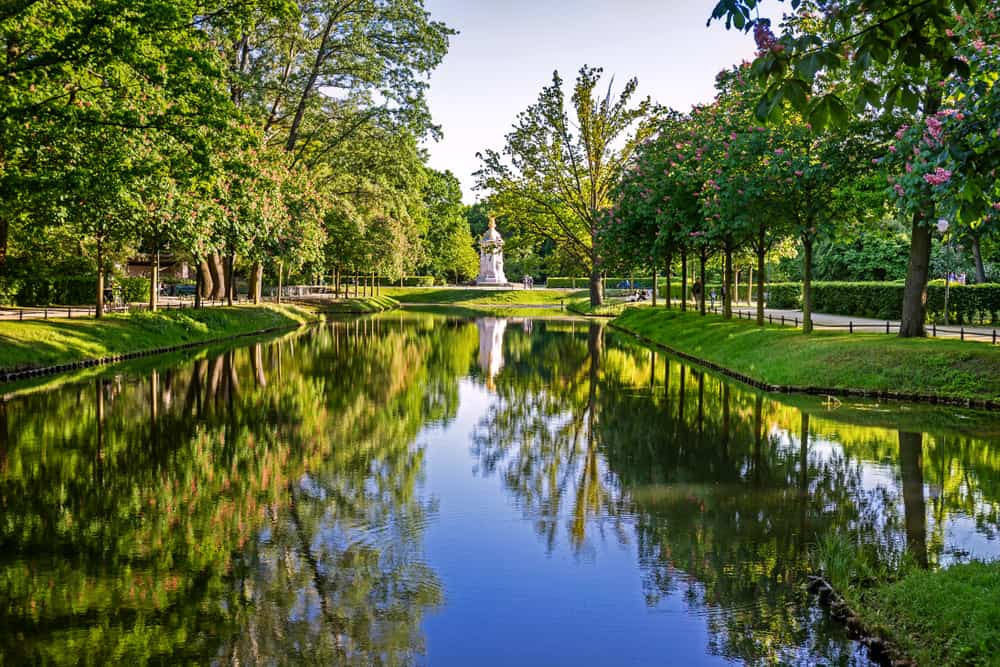
Where to stay near your Day 1 sites:
Luxury: Hotel Adlon Kempinski Berlin. Check rates: Booking.com
Mid-range: art’otel berlin mitte. Check rates: Booking.com
Day 2: Immerse Yourself In The Architecture, Artwork and Artifacts of Museum Island
For your fix of culture and art, head over to Museum Island, the UNESCO World Heritage Site featuring five museums on a small island in the Spree River in Berlin. The museums are all beautifully impressive architectural feats and the island uniquely unites the arts and sciences in one publicly accessible place. Especially when paired with the Berlin Cathedral, it’s very easy to spend a full day at Museum Island.
Stop 1: Explore The Inside Of The Easily Recognizable Berlin Cathedral
Located right on the edge of Museum Island is the Berlin Cathedral (Berliner Dom). It is said to be the largest church in Berlin and one of the most prominent Protestant churches in all of Germany. It is easily recognizable with its turquoise dome, golden cross and Baroque style. If you wish to see the beautiful interior of the cathedral you can pay an entrance fee to go inside. Guided tours are included in the entrance fee or you can choose to explore on your own. Visitors have access to the Sermon Church, the Baptismal and Matrimonial Church, the Hohenzollern family crypt (an eerie but fascinating experience) and the Cathedral museum. For a particularly spectacular 360-degree view of Berlin and Museum Island, climb the 270 steps to the top of the dome. It’s breathtaking and worth all of those stairs.
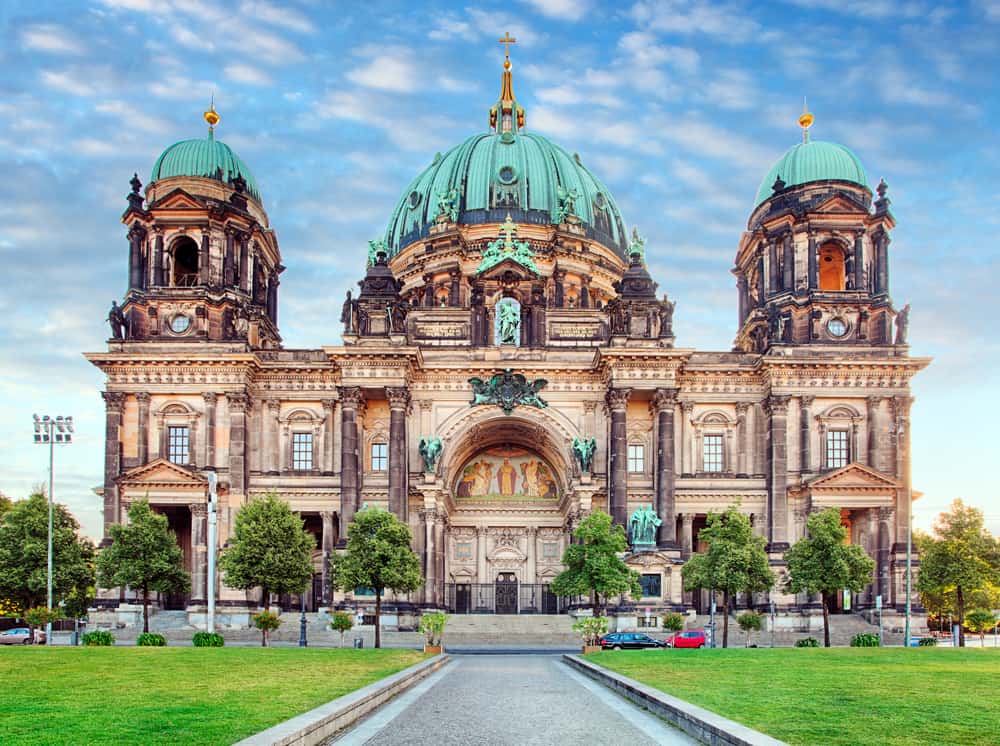
Stop 2: Find Your Favorites Of The Five Museums On Museum Island
The five museums on Museum Island include the oldest museum on the island, Altes Museum (Old Museum 1830), the Neues Museum (New Museum 1859), the Alte Nationalgalerie (Old National Gallery 1876), the Bode Museum (1904), and the most famous of them all, the Pergamon Museum. It’s unlikely you’ll have time to enjoy all 5 museums, so pick a couple that interest you the most.
The Altes Museum once housed the Prussian royal family’s art collection, but now features Greek and Roman sculptures and artwork. The Neues Museum features Egyptian, Early History and Pre-History collections including the much admired Nefertiti Bust. At the Alte Nationalgalerie you’ll be met with stunning artwork from the Neoclassical, Romantic, Biedermeir, French Impressionism and Modernism periods, including works by Monet and Renoir.
The Bode Museum takes you through different time periods with its Sculpture Gallery, Museum of Byzantine Art and coin collection. The famous Pergamon Museum that has people flocking to Museum Island allows you to immerse yourself in the history and artifacts of the Ancient East. You can buy tickets to the museum upon arrival, and buy one ticket for all 5 museums or buy tickets for each museum separately. But if you’re taking public transportation, remember to consider purchasing the Berlin WelcomeCard that includes entry into all of the museums.
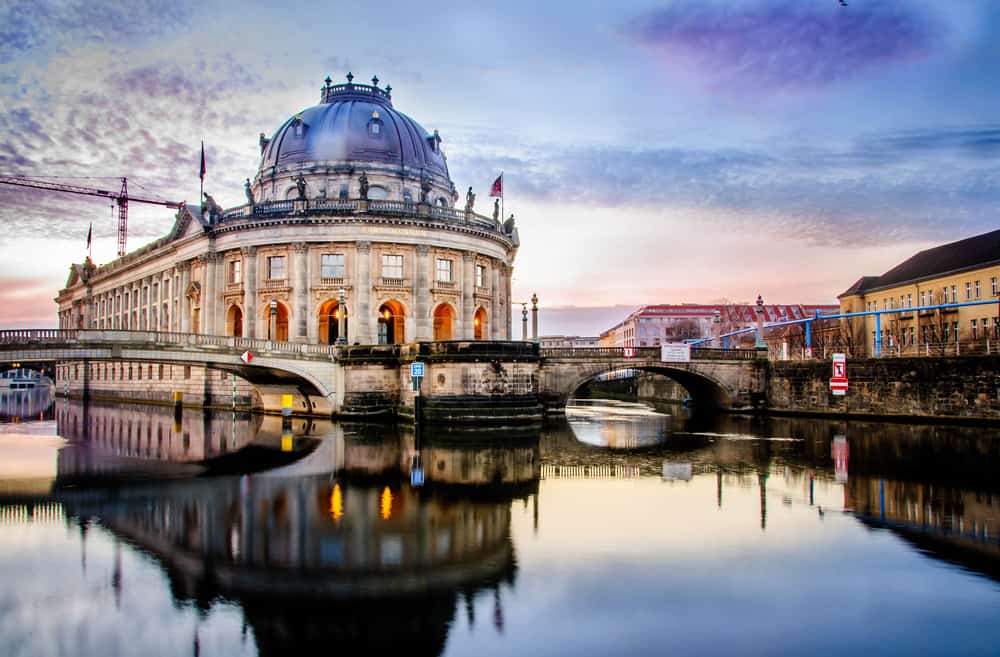
Where to stay near your Day 2 sites:
Budget: Hotel ZOE by AMANO Group. Check rates: Booking.com
Budget/Mid-range: Capri by Fraser Berlin. Check rates: Booking.com
Day 3: Great City Views and A Look At Berlin’s Divided Past Will Round Out Your 3 Days In Berlin
Now that you’ve had your fill of museums, we’re starting the last of your 3 days in Berlin with a brief but impressive stop at the TV tower, followed by a deep dive back into Germany’s history, particularly its divided one. There are few better places to learn about the history of the Berlin wall, the division of East and West Germany and what that meant for the city, than the East Side Gallery and Checkpoint Charlie.
Stop 1: Check Out The Views From The Berlin TV Tower Observation Deck
The Berlin TV tower (Fernsehturm), located in Alexanderplatz, Berlin’s main public square, is the tallest building in Germany (368m) and is still a functioning TV tower. The East German government began construction on the tower in 1965. Now, millions of tourists flock to the tower every year. When visiting this impressive tower, we suggest buying a ticket to the observation deck, which is 203 meters high and gives you a spectacular view of Berlin and the surrounding federal state, Brandenburg. The views can also be particularly striking during sunset. You can choose to have a meal in the rotating restaurant for the same great views while dining. The restaurant rotates once every 30 minutes.
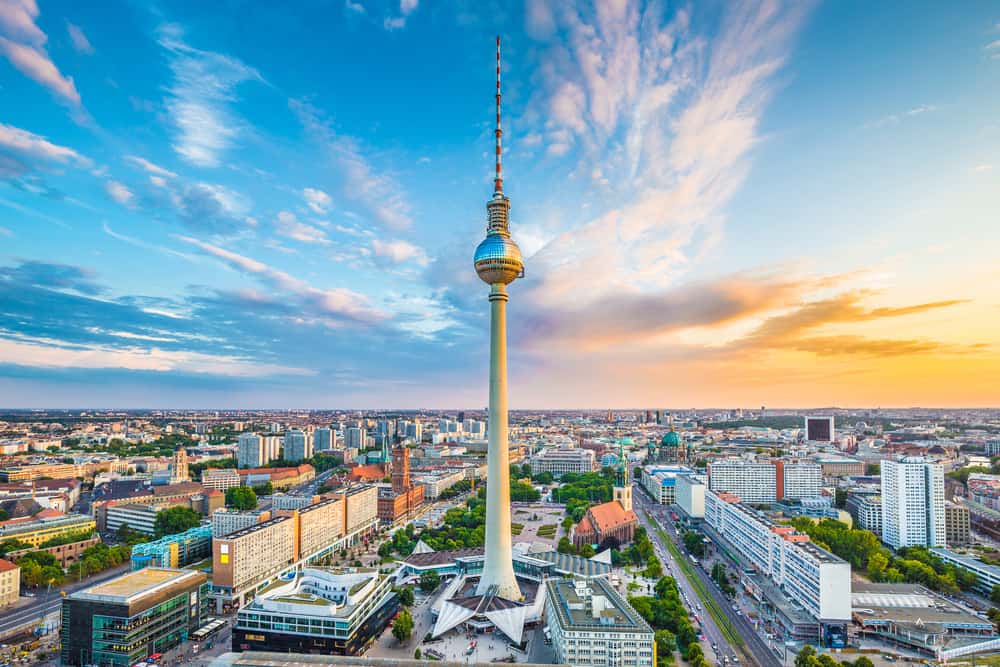
Stop 2: Walk The Historically Significant East Side Gallery
The East Side Gallery is a remarkable 1.3 km remaining portion of the Berlin Wall complete with fascinating artwork. Its importance to Berlin’s history, easy accessibility and location by the Mercedes Benz Arena make it one of Berlin’s top tourist attractions. This section of the wall, built in 1975, is the most well known part of the wall.
101 murals grace the east side of the wall produced by artists from all over the world. Its location on the east side is particularly noteworthy, because up until the fall of the wall, the east side was bare and only the west side had graffiti along its length. It’s worth taking a look at the graffiti and messages on the other side of the wall as well.
The current murals on the east side tell stories of a divided Germany and the struggles that accompanied that division. One of the most recognizable murals is “The Kiss” more formally known as “Mein Got hilf mir, diese tödliche Liebe zu überleben” or “My God help me to survive this deadly love,” created by Dmitri Vrubel. This mural is based off the photograph of Soviet and East German leaders, Leonid Brezhenev and Erich Honecker. Though this is one of the most recognizable, each mural is powerful in its own way. Walking the length of this wall and observing the impressive artwork is fascinating and eye-opening.
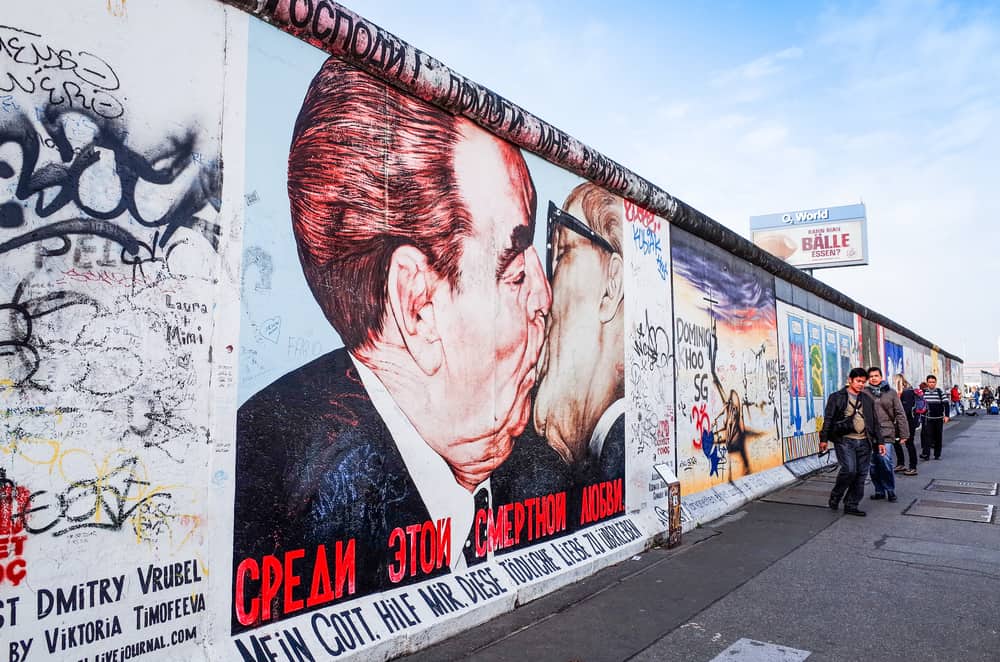
Stop 3: Cross The Line Between East And West Berlin At Checkpoint Charlie
Though Checkpoint Charlie itself is more or less just a booth, it remains a historically significant landmark and is a worthwhile stop. Checkpoint Charlie was the most well known crossing point for Allied Troops and foreigners between East and West Germany during the Cold War. It was here that the standoff between Soviet and American tanks happened that threatened to result in another World War. The checkpoint saw violence, tension and conflict. Just as the Brandenburg Gate became a symbol of unity, Checkpoint Charlie, was a symbol of division.
Today the checkpoint is very touristy with McDonalds and souvenir shops popping up in the area. Many tourists also used to take pictures with actors dressed up as Cold War-era American soldiers, however German authorities have recently banned the actors from the site. Besides taking pictures of the checkpoint, you can also spend some time at the Checkpoint Charlie Museum to learn more about the history of the checkpoint and the Berlin Wall.
There is also a replica of the guardhouse you can visit. The modern day appeal of Checkpoint Charlie is knowing its historical significance. Unfortunately the commercialism of the area and the hustle and bustle of cars and daily life happening around it, have made the actual site feel a little less authentic than some of Berlin’s other historic sites. We still suggest spending some time however long or short to see the site as it is a critical location from Berlin’s not too distant past.
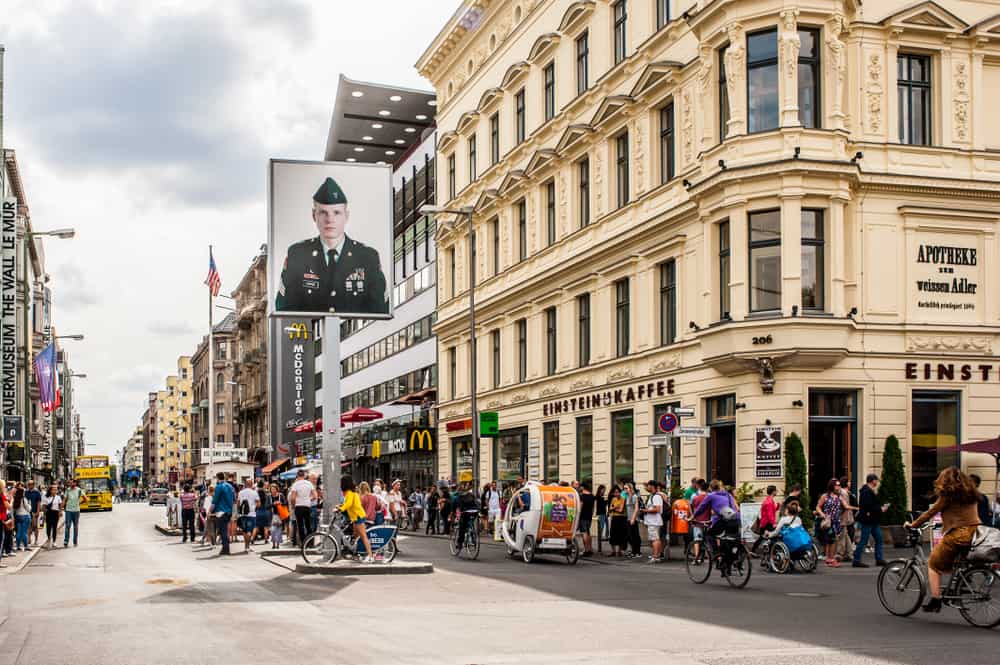
Where to stay near your Day 3 sites:
Mid-range: Select Hotel Berlin The Wall. Check rates: Booking.com
Mid-range: Michelberger Hotel. Check rates: Booking.com
Quick Food Options In Berlin
For the most delicious döner kebabs in Berlin, head to Mustafas Gemüse Kebap. Because Mustafas is notoriously the go-to kebab place in Berlin, the lines can be out of this world long. The average wait time is about 30 minutes and you could easily end up waiting for an hour or more. The food is outstanding, but if you’re in a time crunch, check the length of the line and if it’s not extraordinarily long, the food is worth it.
Right next-door is the king of currywurst, Curry 36. This is a simple but delicious meal. The lines here are also long, sometimes intersecting with the Mustafas line, but the line moves quickly so the wait isn’t too painful.
Beyond Berlin: Explore The Spectacular Palaces and Grounds of Sanssouci Park
Though it’s technically not a part of Berlin, Potsdam is located just outside of Germany’s capital and is a very popular tourist destination that is often paired with a trip to Berlin. Potsdam’s biggest draws are its palaces, in particular the Sanssouci Palace. If visiting Potsdam’s palaces is of particular interest to you, feel free to swap them out for one of the 3 days in Berlin.
The S7 train will take you from the center of Berlin to Potsdam where you can then connect to a local bus or walk to Sanssouci Park. We suggest the later so you can take in the sites of Potsdam as you go. Once at the beautiful, spacious park, you’ll want to head to Sanssouci Palace to begin your Potsdam palace experience. You can purchase tickets individually for each palace or you can choose to buy a combined sanssouci+ ticket for entry into all Prussian Palaces and Gardens Foundation Berlin-Brandenburg palaces in Potsdam.
This ticket is valid for one day and reserves you a timeslot at Sanssouci and entrance into the Neues Palace, though you’ll still have to pick up a timed entry ticket before entering the Neues Palace. If you plan to visit both Sanssouci and the Neues Palace, be sure to check opening days and hours because they differ between palaces. Sanssouci is closed on Mondays and the Neues Palace is closed on Tuesdays. The hours also differ between summer and winter. For visitors interested in taking pictures at either or both palaces for their own private use, be aware that you must purchase a 3€ photo permit.
Stop 1: Be Charmed By The More Intimate Sanssouci Palace
As mentioned, Potsdam is home to the spectacular Sanssouci Palace. This is definitely a highlight of Potsdam you won’t want to miss. Sans souci translates to carefree which was exactly what this summer palace of Frederick the Great was supposed to represent, carefree living. Sanssouci is everything a charming retreat should be. It is intimate and surrounded by a beautiful garden and expansive park.
The park is full of additional architectural beauties and historic sites including the Neptune Grotto, The Temple of Friendship, The Chinese House covered in gold leaf, the Historic Mill that mills corn, the Belvedere of Klausberg Hill, the Belvedere on Pfingstberg Hill, and the Orangery Palace with its plant halls and nod to Italian style architecture. Frederick strongly preferred Sanssouci over the luxury of the Neues Palace which he used to house guests and entertain.
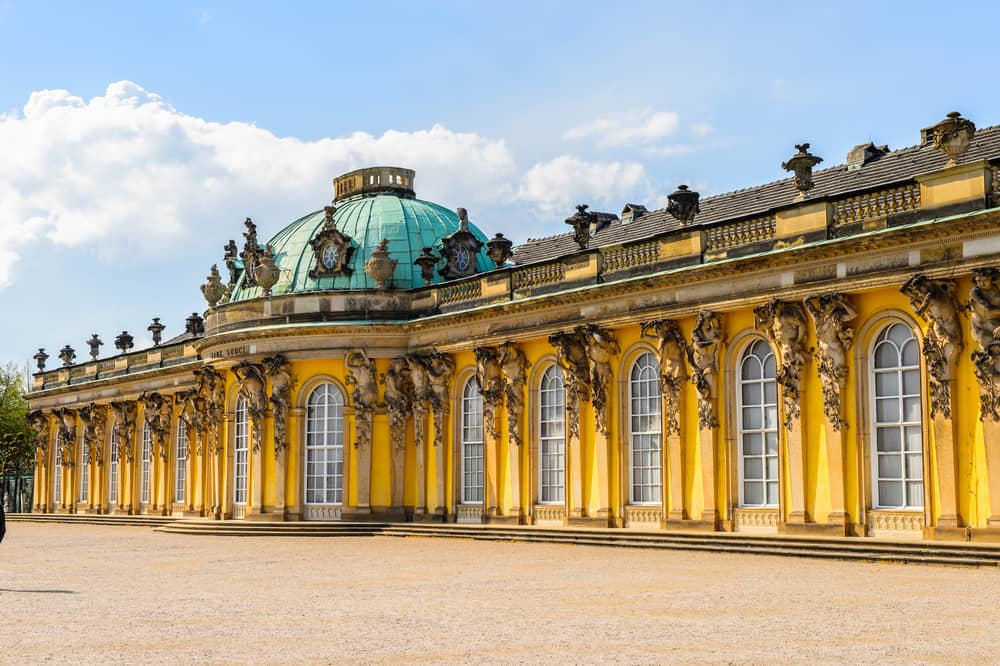
Stop 2: Marvel At The Splendor Of The Neues Palace
The Neues Palace (Neues Palais) is a great Prussian Baroque palace and is worth a visit to observe its splendor and opulence. It is located at the west end of the park right next to what is now Potsdam University. While Sanssouci is intimate, the Neues Palace is over the top grand and lavishly decorated. The palace was built after the Seven Years War. Frederick the Great rarely stayed there himself, but used the palace as a show of power and wealth and a place to host royals and hold royal functions.
The palace is striking from start to finish. The exterior is elaborate with a high tambour dome and beautiful sculptures. As you venture inside, you’ll find the theatre which is a particularly spectacular piece of Rococo architecture. The interior rooms and galleries are sites to behold. The sparkling Grottensaal (Grotto Hall) and the marble and gold Marmorgalerie (Marble Gallery) are particularly impressive. Whether or not you’re a fan of the lavish style, it’s hard not to appreciate the craftsmanship and beauty of the detailed architecture.
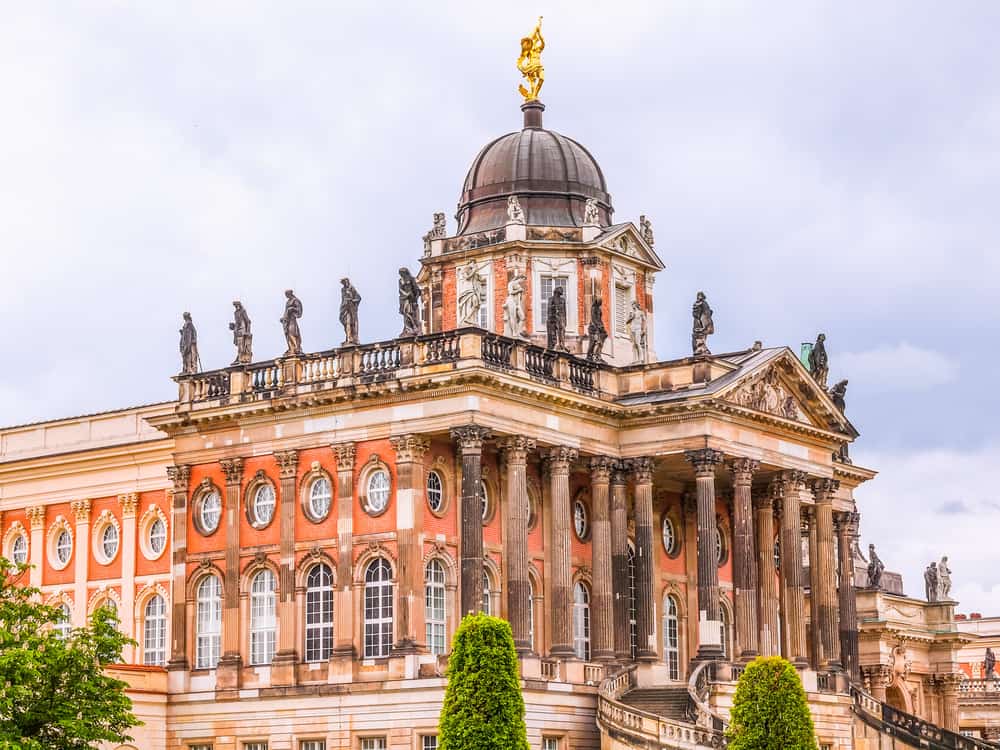
Where to stay in Potsdam:
Mid-range: Hotel am Jägertor. Check rates: Booking.com
Mid-range: Hotel Villa Monte Vino. Check rates: Booking.com
We’re so glad you’ve chosen to explore the wonderful city of Berlin. Berlin’s rich history, impressive architecture and beautiful parks make it a top tourist destination. You’re sure to enjoy your time in this fascinating city. If you have any questions or wish to share accounts of your own Berlin adventures, please comment below!
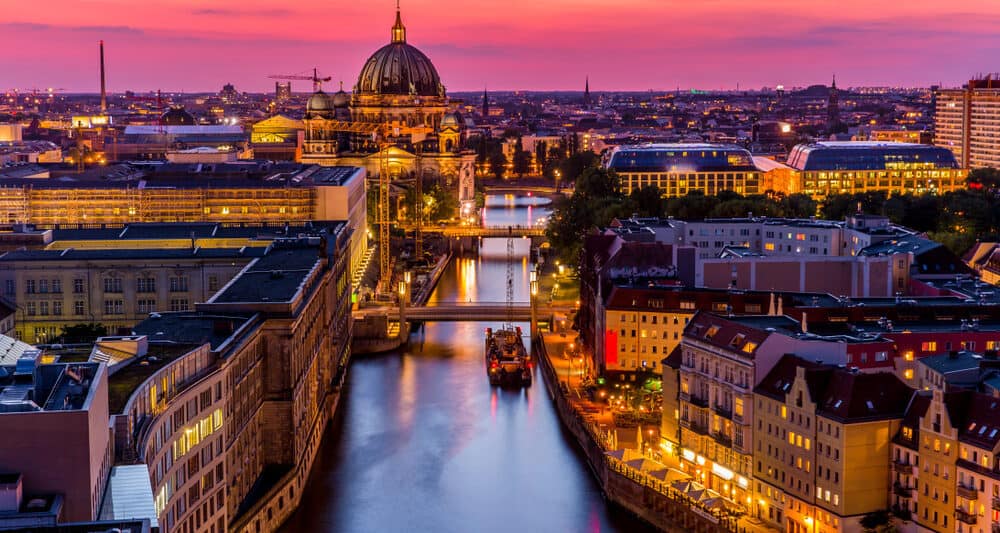
 The Ultimate UK Road Trip Itinerary
The Ultimate UK Road Trip Itinerary